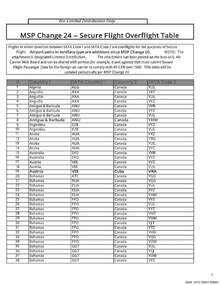| This article needs additional citations for verification. Please help improve this article by adding citations to reliable sources. Unsourced material may be challenged and removed. Find sources: "Secure Flight" – news · newspapers · books · scholar · JSTOR (October 2009) (Learn how and when to remove this message) |
Secure Flight is an airline passenger pre-screening program, implemented from August 2009 by the United States Transportation Security Administration (TSA). Secure Flight matches passenger information against watch lists maintained by the federal government. The initial implementation phase of Secure Flight resulted in the complete transfer of responsibility for passenger watch list matching to TSA from aircraft operators whose flights operate within the United States. The second phase of Secure Flight will result in the transfer of responsibility for passenger watch list matching to TSA for flights into, out of, and over the United States.
Secure Flight is intended to prevent individuals on the No Fly List from boarding an aircraft, as well as to subject individuals on the Selectee List to enhanced screening to determine if they are permitted to board an aircraft.
History
The Intelligence Reform and Terrorism Prevention Act (IRTPA) of 2004 requires the Department of Homeland Security (DHS) to assume from aircraft operators the function of conducting pre-flight comparisons of airline passenger information to federal government watch lists for international and domestic flights. The final report of the National Commission on the Terrorist Attacks Upon the United States (9/11 Commission Report) recommends that this watch list matching function "should be performed by TSA and it should utilize the larger set of watch lists maintained by the Federal Government" (See 9/11 Commission Report p. 393).
To fulfill this recommendation, TSA published the Secure Flight Final Rule on October 28, 2008. The Final Rule went into effect on December 29, 2008.
Benefits
Previously, individual aircraft operators conducted watch list matching using lists provided by TSA. By assuming watch list matching responsibilities from the airlines, TSA will:
- decrease the chance for compromised watch list data by limiting its distribution
- provide earlier identification of potential matches, allowing for expedited notification of law enforcement and threat management
- provide a fair, equitable, and consistent matching process across all airlines
- reduce instances of misidentified individuals
- offer consistent application of an expedited and integrated redress process for misidentified individuals via the Department of Homeland Security's Travel Redress Inquiry Program (DHS TRIP), a method by which misidentified travelers can file an inquiry to have erroneous information corrected in DHS systems
Implementation
Secure Flight began implementation with select domestic aircraft operators at the beginning of 2009 and completed implementation for all covered domestic and international airlines in December 2010.
TSA's Office of Threat Assessment and Credentialing is the lead for the program. Contractors supporting the program have included IBM, Accenture, ESR, InfoZen, and Deloitte. Infoglide Software provided the underlying identity resolution technology.
TSA met its goal to vet 100 percent of all domestic commercial flights by early 2010 and 100 percent of all international commercial flights by the end of 2010.
Privacy
TSA has stated it will not collect or use "commercial data" to conduct Secure Flight watch list matching. It has also released a Privacy Impact Assessment (PIA). The TSA policy, however, makes no mention of any limitations on what the airlines themselves, who collect the sensitive (birth date, etc.) information, may do with this.
Secure Flight has many similarities with CAPPS II and the No Fly List, and therefore raises the same validated concerns about civil liberties and due process. Specifically, civil libertarians argue that under the Secure Flight program, there are insufficient redress mechanisms for innocent citizens on watch lists. Additionally, the content and quantity of the watch lists has fallen under scrutiny.
Overflight
The Secure Flight Programme applies to non-US flights overflying the United States. TSA uses a table of airport pairs to determine if a flight is overflying the United States.

See also
Sources
This article incorporates text verbatim from this website, a publication of the US Transportation Security Administration, in the public domain.
- Martín, Hugo (2010-12-06). "All airline passengers are now checked against watch lists, Homeland Security says". Los Angeles Times.
- Secure Flight Hits More Snags. Informationweek (2005-10-03). Retrieved on 2013-08-20.
- Wood, Douglas (1 April 2009). "TSA'S Secure Flight Program Using Infoglide's Identity Resolution and Entity Analytics Software for Airline Watch List Matching" (Press release). Austin, Texas: Cision PRWeb. Archived from the original on April 6, 2009. Retrieved 24 September 2019.
- ^ Archived February 25, 2009, at the Wayback Machine
- "TSA and FBI Ordered to Pay $200,000 to Settle "No Fly" Lawsuit" (Press release). American Civil Liberties Union. 24 January 2006. Retrieved 2006-12-16.
- "Secure Flight Re-Engineering Welcomed but Watchlist Problems Remain Unaddressed" (Press release). American Civil Liberties Union. 22 October 2008. Retrieved 2009-04-26.
External links
- Secure Flight Home Page
- Official DHS Press Release
- Secure Flight FAQ (The Identity Project / PapersPlease.org)
- ACLU Response to Secure Flight Final Rule Announcement
- USA Today Coverage of Secure Flight Final Rule Announcement
- Secure Flight Privacy Impact Assessment (PIA)
- Secure Flight System of Records Notice (SORN)
- DHS Traveler Redress Inquiry Program (DHS TRIP)
- The Final Rule
- Carrier Data Interfacing to Secure Flight